Analysis of Fakes
Annotated comparisons of fakes and genuine images will be posted here in a step-by-step manner.
– Magda’s head – comparison
– Forgery “Kompozice”
– Fakes by their “style” (with examples and comparison)
Magda’s head
|
Bělocvětov’s drawing has only a line instead of a neck and yet the neck is there and fits beautifully. |
Falzum tries to imitate it (based on a similar drawing) – and of course it’s completely wrong. [Unfortunately we don’t have the original drawing – that would make the comparison all the more interesting]. |
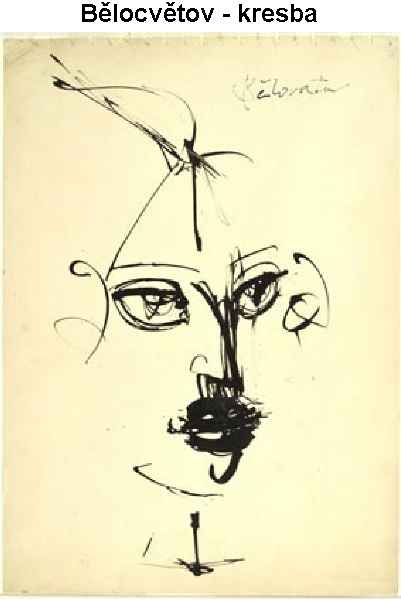
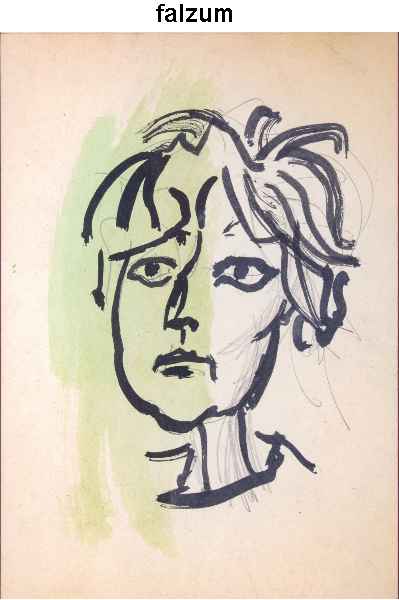
Bělocvětov – like other masters – achieves in linear drawings the optical impression of volume and space by “merely” applying pressure and relaxing the hand while guiding the line. Also, the often quite slight curvature of the line in the right place and in the right shape, can create a surprisingly suggestive impression of spatiality. (on this, see Kořán “on the sovereign line”)
The exact size ratio and the angles of the planes of the object being depicted matter a great deal – just a slight shift and everything would be wrong.
The relative angles of the eyes and the two locks of hair, place the face in space, including its proportions. Very important is the comparison of the neck, chin and forehead in the exact axis ( it is worth noticing the strand of hair falling into the forehead, which stretches it to the beginning of the hairline). Here – together with the other three lines – they form an intersection that models the top of the head. The line from the top of the head to the back models both the shape of the head, and the whole space of the picture.
Falsifier quite obviously imitates a real drawing with a very similar composition. The lines forming the outlines are monotonously blunt, heavily “drawn” by an unused hand and the head thus remains hopelessly two-dimensional.
The outline of the face here emerges as a potato-shaped deformed scrape, without the back volume of the head directly mounted on a hollow tube representing the neck. The “face” with the “neck” do not suggest a sense of muscular tone, nor a perceived solidity of tissue and skeleton. The vaguely outlined line of a kind of collar from which the “neck” protrudes, does not in any way evoke its connection to the torso. (A.P-B.)
A set of falses entitled “Composition”
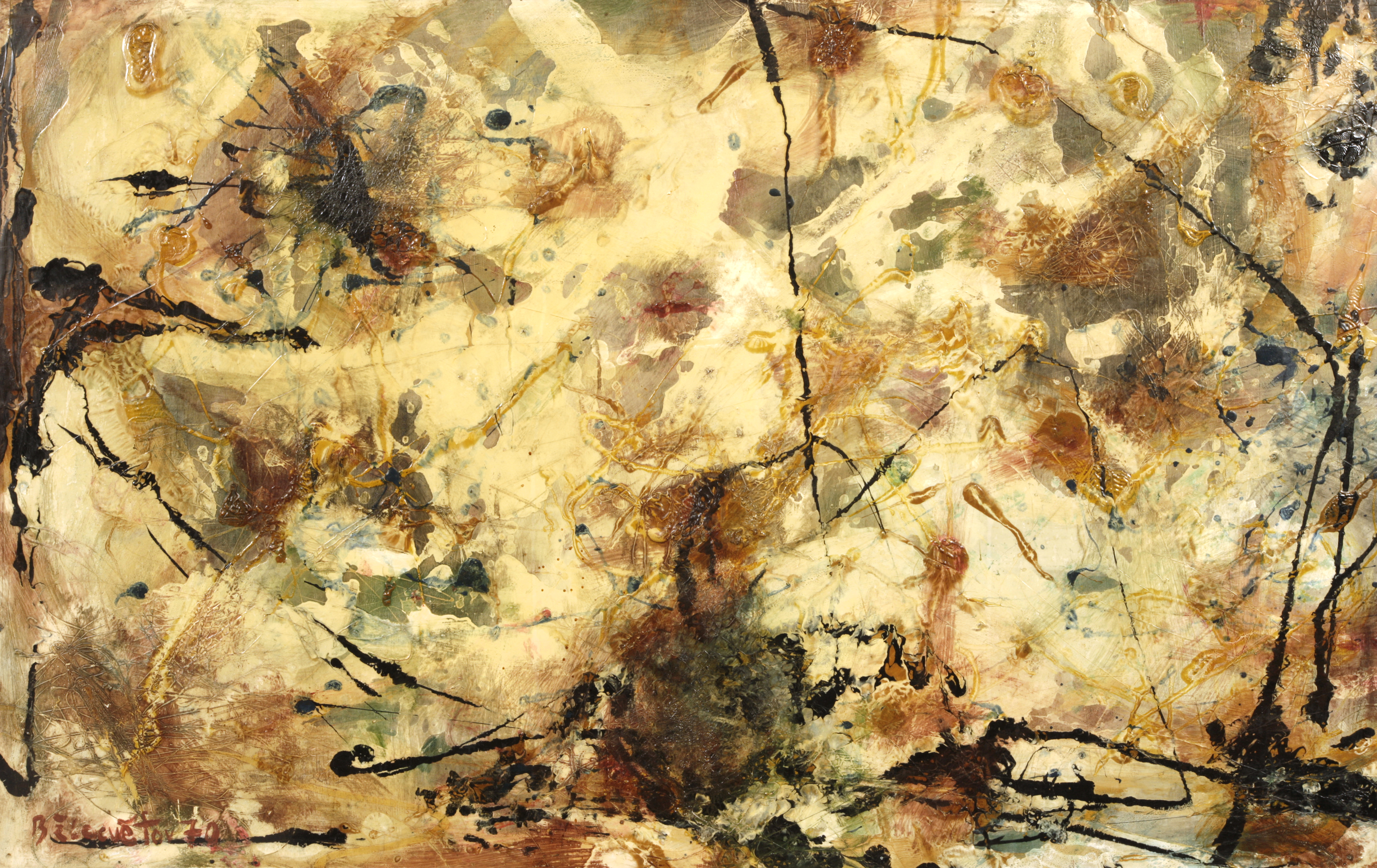
By way of introduction, a few contexts accompanying not only this fake
False paintings by Andrei Bělocvětov are for sale in galleries and auction houses:
I would like to begin by saying that while I like to write about Andrei Bělocvětov’s genuine paintings with pleasure, I find writing about the fakes of his paintings a frustrating experience. For the sake of the work, however, this situation must be addressed, and I consider it my inescapable duty.
The problem of the fakes of this painter’s works lies mainly in the long-term and massive production of fakes, both for the purpose of direct sale at auctions and for presentation at exhibitions along with genuine paintings, of course also with the aim of subsequent sale. In many cases, the same fake is exhibited and resold several years apart, and a situation arises where gallerists cite the previous history of the fake as an argument for its authenticity.
It should be remembered that not everyone who has a fake in their hands is aware of its problematic nature, which complicates matters even further.
It is a matter of fact that the false paintings are always “signed” and bear many “proofs” of authenticity (titles, dates and various specifications on the reverse). The written descriptions are scrupulously accurate. I call attention to the fact that many of the forgeries have the title “Composition”, while it is the composition that is completely lacking.
I shall attempt to illustrate one of these methods of selling falsehoods by the case of a falsehood presented under the name of :
“Composition, oil, varnishes, sololite, 71×110 cm, signed LD Bělocvětov 70”
on the reverse “A. Bělocvětov 1971-72”
The “painting” was exhibited in the past (possibly repeatedly) and subsequently sold. Its current owner is now offering it at auction in a Prague gallery.
Selection
Unlike genuine paintings by his father from any period, this piece lacks meaningful content and – not only figurative – any other composition. 1)
Technically, the forger here is merely exploiting the different properties of the bases of the materials (paints) on the surface, whereby a process of embedding and subsequent precipitation of colour patches occurs, which in effect “paint themselves” by creating completely random shapes. If a true artist uses such a method, he will use this technique purposefully with a clear intention and meaningful result. This is different from a forger who leaves them as they are – so that the whole gives an amorphous, “cotton woolly” impression. At the same time, because he realizes that there should be some “drawing element” after all, he adds an embarrassed attempt at dripping and a few vague, clumsy lines that have nothing to do with the virtuosity of Bělocvětov’s drawing. Indeed, even the simplest drawing is what, among other things, is completely lacking in the falsifier’s “arsenal”.
Another glaring inconsistency in the falsetto “Composition”, is its date (1970). In the 1970s the painter had already abandoned the stylistic form of the 1960s, i.e. encrypted expressive paintings with often abundant use of dripping across the surface, and began a synthesis of previous styles (even here, however, his works always have figurative content). The paintings of the 1970s period have solidly built shapes that undergo very sophisticated metamorphoses, but always retain their robust plasticity. In this and subsequent periods, Bělocvětov still occasionally employs elements of dripping, but now only to complete the detailed characteristics of the objects depicted, rather than the overall composition.
The “Composition” falsum bears a signature that is not the artist’s actual signature, nor does the inscription on the reverse of the painting show the characteristic features of the painter’s handwriting.
This brings me to another, related problem: most gallerists and collectors lose track of which signatures are genuine and which are not. They cannot even follow this usually relatively simple guide (some may even know more false signatures than true ones). Moreover, many of the forgeries bear the same stamp as the one the painter’s second family had made after his death.
In conclusion, I would like to stress that if this extraordinary work continues to be treated in this scandalous way, it may be declassified to such an extent that future generations will not be able to recognize its true value, and thus it will be largely lost to them. Therefore, I appeal to you, all true lovers of fine art. To you, for whom art is an inseparable part of life, not just a profitable investment. Please help me in my efforts to cleanse the work of one of the most important painters of Czech modernism from the ballast of plagiarized and clumsily caricatured imitations. I will be happy to advise on any doubts about the authenticity of specific works, or answer other questions about my father’s work.
Andrea Pilarová Belotsvetová (A.P-B.)
———————–
1)
I guess the above terms probably don’t mean much to people unfamiliar with the matter. However, for those who are in the business of selling paintings as a profession, such a point of view should be the most basic in determining the quality of a work (which in turn is the main determinant of its authenticity – certainly so for this artist).
Dividing falsities by their “style”
In order to be able to analyze the falses of Andrei Bělocvětov’s paintings, I am forced to engage in a thorough study of them.
At first glance, their basic feature is obvious: a boundless and muddy amorphousness, the absence of aesthetic forms, no hint of meaningful composition. As I penetrate more and more into the essence of the matter, I gradually begin to recognize other characteristics – especially the different “styles” of the creators of the falses.
1. The primordially amorphous, where the falsifier hides behind the vague formlessness of something, which is then usually called equally vaguely “composition”, “untitled”, etc.
False Type 1:
We cannot display this galleryFalza type 2:
We cannot display this galleryAndrei Bělocvětov’s work – given his extraordinary talent and nearly sixty years of continuous development – is of such a high standard that it is virtually impossible for even a well-crafted professional to imitate it faithfully. Even more so for one who does not even know the basics of the craft, let alone its most difficult part – human anatomy.
False Type 3:
We cannot display this gallery4. The last group is represented by the falses, in which the forger attempts to “create his own work on the given theme”. Either also with a distorted use of elements from different periods of the artist’s work (again, the problem with ignorance of anatomy), or completely “on his own axis” (in this case he tries to imitate only the signature).
Type 4 phalanx:
We cannot display this gallery
The division of phalluses into these groups is, of course, only a framework, serving mainly to simplify their analysis and to better understand the issue. As with any similar phenomenon, we can observe various combinations and subgroups.
Example of a falsetto: Type 3-4:
Falsum “Female Nude”,
Oil, cardboard
39.5 x 54.5 cm (h x w)
Signed: “Bělocvětov 1980”
For comparison
two real figures
Falzum
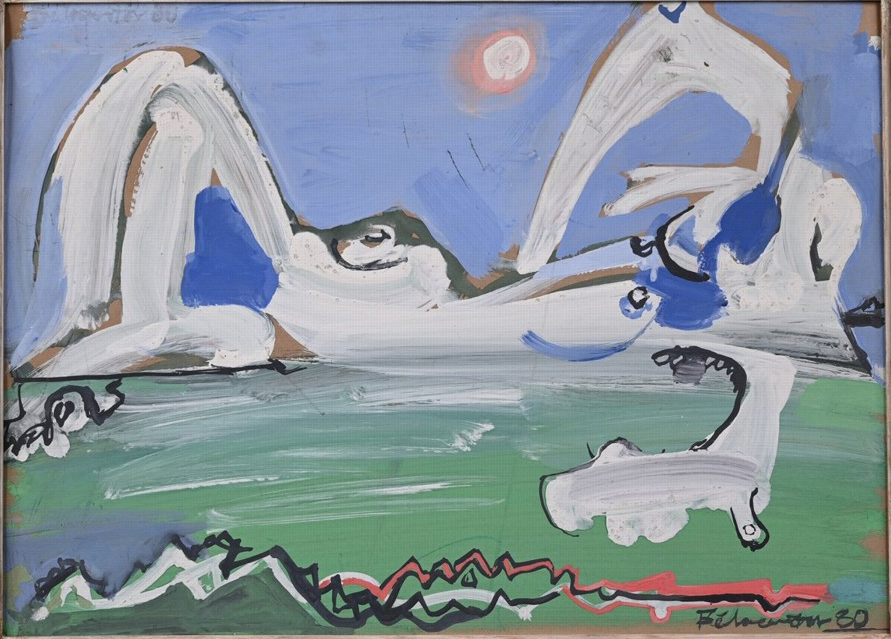
Bělocvětov – Mother with dead child
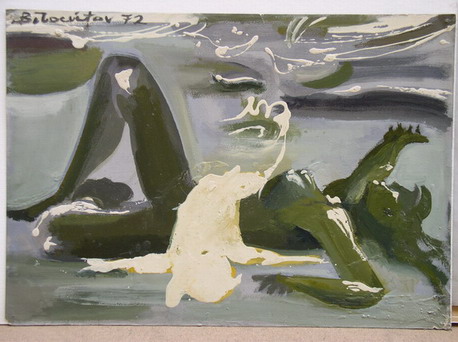
Bělocvětov – Reclining Nude
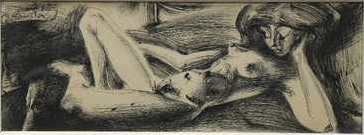
The falsum, which was recently sold in a Prague auction house, can be classified in a combination of the third and fourth groups, according to the above division. Given Bělocvětov’s perfect knowledge of anatomy, it is clear, that no figurative work of his (with any great degree of stylization), can contain such elementary and glaring errors.
The fact that the forger has tried to use shaped elements from genuine works does not mask these errors, and certainly does not mask their distorted and inorganic use.
As for the “figure” itself, which is (unfortunately) the central motif here, let me quote at the outset the words of my father’s friend and great promoter of his work, prof. Vladimir Franz: There lies a god, a head helpless, legs, arms … and also the “ornamentation” in the foreground, completely dull …
His words, as always, hit the nail on the head – the words “helpless” and “poor” are indeed the most apt characterizations of this carcass, and indeed of all its ilk. Bělocvětov’s figures are always vivid and without a single flaw, even in the most difficult stylizations.
But what kind of monster is this, which grows something like an arm out of its stomach, which has something like breasts in reverse, and which extends to the horrified spectator a crippled patch, apparently representing an arm? A strange cake-like formation, representing a belly and stumps, with which a professional cripple could make a fortune, completes the “work” glued to the painted back plan of a “sky” with a tiny, colourless sun, taken from three-row bazaar landscapes.
It is worth noting that the shape stylizations, which the forger attempted to imitate, date from the 1990s, but the signature is dated 1980. It is clear that the forger’s “flight”, was a decade ahead of its time. He was simply trying too hard.
Because the “image” has – according to the gallery owner – such a crystal clear and unquestionable origin. It is, of course, above all …
Example of a fake: type 4:
Falsum “At the Table”
1950s
Oil, canvas – 37,5 x 28,5 cm (h x w)
Signed: “Bělocvětov”
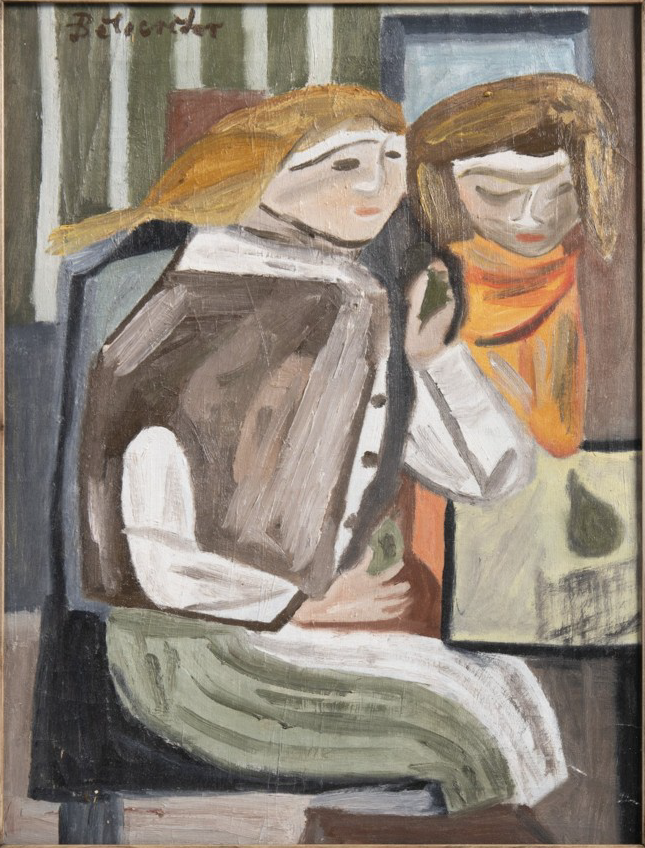
This falsum was offered in the same gallery, but fortunately failed to sell. It reveals the same forger, as “Lying Woman”
Same lack of elementary knowledge of the craft, same ignorance of the anatomy of the human body. Typical “poor head” without a cerebellum, plaintive, beginner’s folded hands. The “figure”, which is closer to the viewer resembles a rather shapeless sack of clothes, its arms grow somewhere above the thought waist. The wrist of her left hand does not connect to the sleeve, sticking out awkwardly into space in the background, with no connection to the “body”. The second “figure” has no hint of arms, her face transitions vertically directly into a rectangular shape, representing the body. She is separated from it only by a kind of “collar”, which seems to replace the neck.
Both figures are flat, lacking rear volume. Perspective is lacking even in such a simple shape, as a table top. Even such and even worse “creations” – with the abundant help of “informed” gallerists – are successfully sold.
Example of a falsetto: type 3 – on the right is the original, according to which the falsetto was made:
Falzum
_BAC44792.jpg)
Bělocvětov 1991
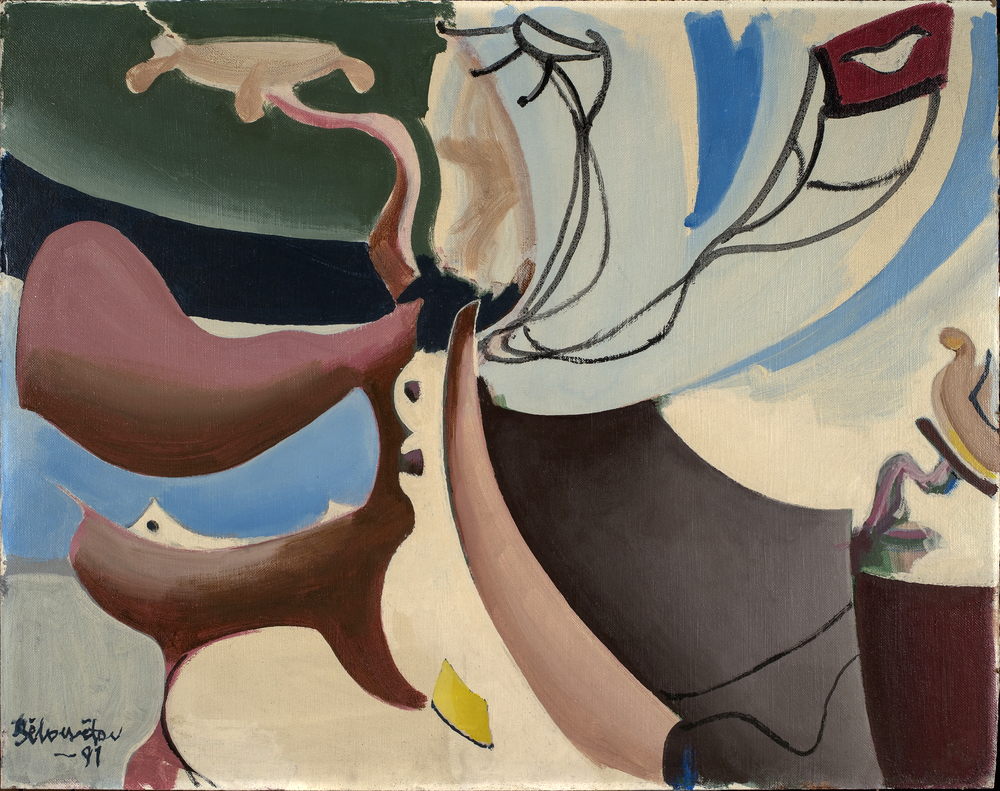
Shape-composition analysis of the original:
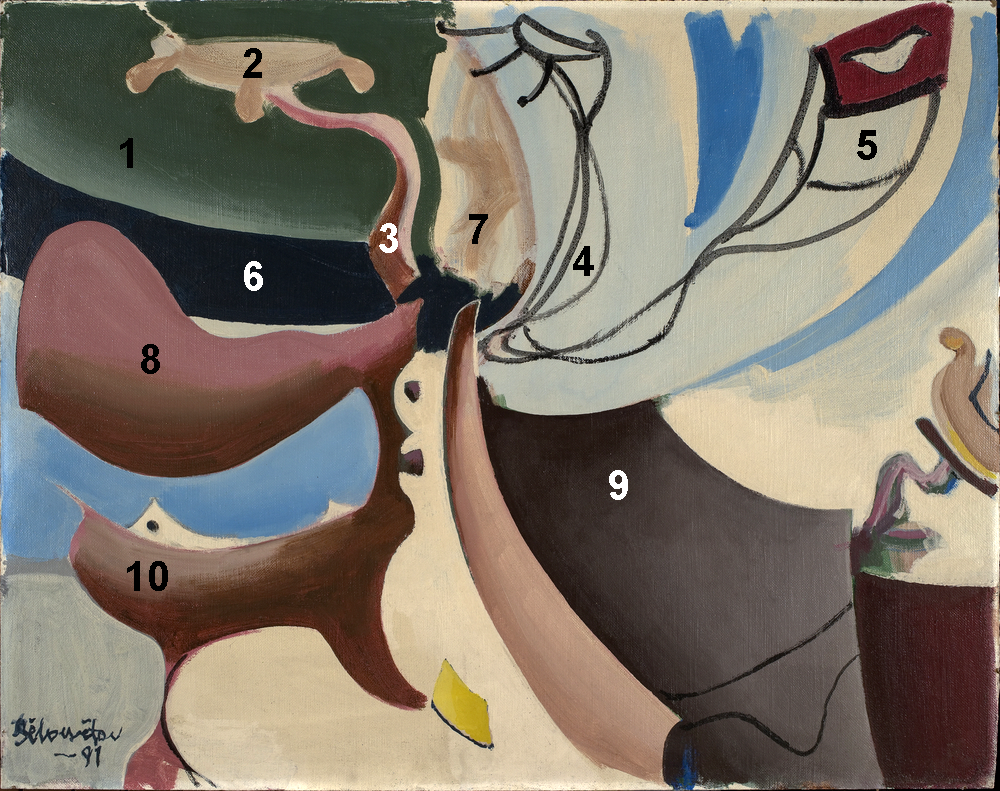 The grey-green area of 01 models the upper left of the painting, the darker front part of 06 forms – with the help of a subtle light glaze – an edge, projecting forward. Above it, the “arm” 03 floats upwards and backwards through space, with the “hand” 02 facing forward. These are metamorphosed into a strange floral formation, casting a subtle shadow on the 07 conical object. The deeply modulated surface of 09 balances 01 compositionally, pushing the upper plan of the painting far back with an illusion of overwhelming space. The shape of 04, pointing backwards and forwards in an arc in space, is connected to 05 at the centre of the composition, projecting outwards from the image. While their translucent cartoonish shapes lighten the sturdy weight of 01 upper left and 09 lower right corners, the chrysalis-like shape of 08 on the left, is “picked up” by the deep blue of the vista (perhaps directly into outer space. .. ?). However, it does not float uncoordinated, it is anchored by the lower “limb” 10, morphed into an animal shape, buckling on the white ground with solid legs. Here we suddenly discover, that the blue space is leaf-like and curved, forming a counterpart to 09 … Similarly, we can go on for a long time, White’s paintings are multi-layered in content. This never-ending play, this constant escapism has certainly been a constant source of joy for the artist. If we take the trouble, we can share it with him …
The grey-green area of 01 models the upper left of the painting, the darker front part of 06 forms – with the help of a subtle light glaze – an edge, projecting forward. Above it, the “arm” 03 floats upwards and backwards through space, with the “hand” 02 facing forward. These are metamorphosed into a strange floral formation, casting a subtle shadow on the 07 conical object. The deeply modulated surface of 09 balances 01 compositionally, pushing the upper plan of the painting far back with an illusion of overwhelming space. The shape of 04, pointing backwards and forwards in an arc in space, is connected to 05 at the centre of the composition, projecting outwards from the image. While their translucent cartoonish shapes lighten the sturdy weight of 01 upper left and 09 lower right corners, the chrysalis-like shape of 08 on the left, is “picked up” by the deep blue of the vista (perhaps directly into outer space. .. ?). However, it does not float uncoordinated, it is anchored by the lower “limb” 10, morphed into an animal shape, buckling on the white ground with solid legs. Here we suddenly discover, that the blue space is leaf-like and curved, forming a counterpart to 09 … Similarly, we can go on for a long time, White’s paintings are multi-layered in content. This never-ending play, this constant escapism has certainly been a constant source of joy for the artist. If we take the trouble, we can share it with him …
The figurative composition “The Merry Woman” from 1991 is an illustrative example of a meaningful stylization, transforming a profane reality into a new reality, which is, however, just as true. Its veracity is determined by the same precise, even more strict laws, than the depiction of the so-called “woman”. The demonstration of this order is easier if we limit our analysis to the technical side of the work (composition, shape relations, etc.) and do not deal with the content side for the time being.
The painting has an almost musically harmonious composition, in which the human figures morph (while maintaining the correct proportions) into a kind of strange vegetation, and are even connected with elements of a purely technical nature. Compositionally, it is loosely related to “The Invincible Weepers” from the painter’s late surrealist period. (A.P-B.)